Margot Note's Blog, page 15
February 13, 2023
Archival Arrangement Principles
Archivists provide clarity to collections. They help users understand records of enduring value: what they are, who created them, and what events they represent.
To do so, they identify groupings of records. Then, they explain aggregations of records through appraisal, processing, and description. Through the archival process, archivists transform complex groupings of primary sources into insightful and succinct information through arrangement and description.
The relationship between records creators and their activities is revealed by how creators kept records. When groups of related records are discovered, they should be maintained. To do otherwise may result in losing information about how the records were created. Standard aggregation methods start at the general groupings and get more granular.
Original OrderWhatever method creators use to file records, the arrangement should be preserved in the archives. Archivists correct filing errors and restore order to sections that became disorganized over time. However, restructuring a filing system is unnecessary and ill-advised. Archivists prefer that records be maintained in their original order, as it guides the interpretation and understanding of records, revealing events, processes, and other organic activities. Archivists preserve this evidence for future users.
Provenance and Respect des FondsAnother archival principle related to the original order is provenance or respect des fonds. The principle of provenance requires that the arrangement of records reflects the structure of the organization that created them. The records are arranged in a way that reveals the hierarchy of the records creator. Adhering to this principle preserves the evidential value of the records: evidence of the structure and functions of the organization.
Respect des fonds is a French term for the same principle, which prohibits mingling the records of different creators. Thus, the principle of provenance discourages the wholesale rearrangement of archives. Instead, archivists can highlight information on related topics or subjects without obscuring the primary purpose of the archives, which is to document the institution, its structure, and its activities.
Keeping the records of one creator separate from the records of other creators—physically and intellectually (through description)—ensures that contexts of creation and maintenance are preserved.
Record GroupsApplying the principle of provenance facilitates the creation of record groups: the building blocks of archival arrangement. The record group is an assortment of materials related to activities or creators. For example, an organization may have a record group of materials created by a board of directors.
SubgroupsSubgroups are the next level of the archival hierarchy. There is a subgroup for each functional subdivision under the record groups. For example, in a board of directors’ record group, subgroups exist for the functions overseen by the board, such as committees, fundraising, or significant projects.
Series and SubseriesWithin the record group and subgroups, series are the next subordinate records grouped based on their creation, activity, use, or form. Series within a board of directors’ record group might include annual reports, minutes, and correspondence. Series subdivide even further into subseries when appropriate. For example, a correspondence series might divide into subseries for incoming and outgoing correspondence.
File Unit (Box or Folder Level)With the series and subseries, archivists may have descriptions based on boxes or folders. These are units into which items are grouped for filing. For paper records, folders may contain several documents or items. For instance, a file unit for a board of directors may be a folder of correspondence from a particular year.
Document (Item Level)The document is an individual item, such as a photograph, a memo, or an annual report.
Archivists often do not focus on item-level material unless the item is of particular importance. One example could be the founding document of the board of directors, which would have significant historical value to an organization.
Levels of arrangement allow archivists to create physical and intellectual order to collections. Applying archival principles and arrangement levels preserves the context of the collections and represents the records over time as the archivist understands them.
The blog was originally published on Lucidea's blog.
Get StartedLooking for archival advising, records management, and historical research services? Click below to speak with an expert consultant.
Contact
February 6, 2023
Archival Program Advantages
Organizations benefit from records and archival management programs in both tangible and intangible ways.
The purpose of an archives is to preserve and make accessible the various elements of the historical and enduring value of a business, organization, agency, family, or other entity. Significant components include files, photographs, correspondence, legal documents, press clippings, and a wide range of informational items in between.
Intangible AdvantagesIn some instances, the intangible and unmeasurable benefits may have the most impact. For example, an archives contributes to an institution’s goal of promoting social responsibility. Suppose the organization exists to benefit the community—its clients, patrons, customers, and colleagues—and to improve social, cultural, or political conditions. In that case, maintaining an archives can be an act of social responsibility. In addition, an archives preserves information about the organization by documenting its past. This documentation is invaluable, informative, and educational to various potential users.
An archives contributes to the organization’s pride and improves morale among its members and constituents. Materials from the archives illustrate an institution’s history, stimulate enthusiasm, and encourage members to maintain the organization’s values and future. Organizational pride creates an environment of strength and hope.
Tangible BenefitsControlling past, current, and future records also has practical advantages that decision-makers in leadership positions understand.
Daily operations frequently require using noncurrent records of enduring value. For example, an anniversary publication that outlines the organization’s achievements is easier and faster to produce if an archives exists than searching through other sources or depending on institutional memory. In addition, the information necessary for the publication is readily accessible to create an accurate account of an organization’s activities.
Having systems, policies, and procedures in place helps records be filed orderly to facilitate retrieval. Whenever records are needed, employees confirm their existence, determine their location, and retrieve them.
Organizational archives support marketing, advertising, and public relations. An institution’s past successes attract interest, commitment, and contributions. Discussing, documenting, and illustrating activities of the past lends credibility to the organization in its recent efforts. An archives preserves an institution’s history of achievements and transforms past glories into current political capital. Successful programs demonstrate the organization’s credibility, strength, and longevity.
The existence of an archives boosts strategic planning. Decision-makers can look back at their organization’s history to learn which efforts succeed and why. In some instances, exploring failures through the lens of history and the distance of time can also bring insight into current activities. Understanding errors, as well as successes, determines future strategy. An archives reveals which activities helped the organization and its beneficiaries. Present interest areas are compared with past efforts and evaluated for their future potential.
Archives are also helpful for legal purposes. Whether defending itself against actual or threatened litigation or acting as a plaintiff, the organization can rely on the effort of a records management and archives program. In legal proceedings, information is power, and the archives can support a legal strategy that supports the organization.
Benefits to the CommunityWhen organizations maintain archival records, the public benefits because the records have educational or historical value. The records of all types of organizations may be available for use in repositories.
Researchers investigate the archival records of organizations not only to find out about the institution itself, its members, leadership, structure, and activities. They can also discover whatever they can about issues important to the organizations. Community organizations, for example, participate in and promote grassroots political organizing, citizen participation in government, voluntarism, and social activism.
A Commitment to CareOrganizations benefit themselves and the public by directing efforts toward preserving their records, organizing them, and making them available to those inside and outside the institution. The commitment to reliable record-keeping begins with records maintenance.
The blog was originally published on Lucidea's blog.
Get StartedLooking for archival advising, records management, and historical research services? Click below to speak with an expert consultant.
Contact
January 30, 2023
Advocating for Archives: Tips for Archivists
To advocate for the archives appropriately, archivists should have deep knowledge of their repository.
Although other staff members may be familiar with archival materials, those working daily with archival materials should be familiar with the specific challenges of their repository and, most importantly, how these issues affect archival policies and procedures. The perception of resources, services, and users should also be well understood.
Understanding current practices in the field is essential to keep archivists updated on their knowledge. The world of information moves quickly, and the archives should keep pace with how the repository is run. In addition, archivists should evaluate their work to ensure they are doing what they should to preserve materials—and what practices they may consider reducing or removing altogether. Taking time quarterly to review progress allows archivists to decide what activities need to be prioritized and what benefits they provide for the organization.
Messaging as BrandingArchival workers should consider the messaging the repository promotes on its website and during virtual and in-person situations. The archival team can identify advocacy content that fits into customer service interactions, represents the archives’ perspective, and articulates its needs. Even the most seasoned user may not understand the fundamentals of how the archives operates, so archivists should use opportunities to educate the public about the value they create with their work.
Archives can often be viewed as intimidating to users. Consider how users first encounter the archives through its website, online materials, and in-person interactions. What can be changed to lower barriers to entry for users and create a positive experience that also works within the organization’s culture?
Reference Staff as AlliesReference archivists have the most experience with users. They can pick the appropriate moments to deliver archival advocacy talking points. The best advocates learn to identify moments for advocating by reading users to gauge their interests. They can also use opportunities to get to know their users. Good archival planning includes environmental scanning that provides profiles of users that assist in planning for resources, services, and programs. Profiles aid in identifying advocates as well as exchanges that might be more successful between archivists and users. Archivists can use follow-up protocols to promote positive experiences. Even better, archivists can consider how all user interactions can be enhanced to provide a welcome experience.
Working with the PublicArchivists should pass along user comments, both good and bad. They should track comments and inform their supervisors about user complaints and compliments. In addition, they should pass along user questions. Finally, archivists can track comments and let their supervisors know questions regarding advocacy issues and initiatives.
Archivists keep advocacy at the top of their minds by discussing issues during staff meetings. Organizations should ask colleagues how to distribute messaging to help raise the archives’ profiles. In addition, they can distribute advocacy content to assist in creating an advanced network of advocates. To accompany verbal interactions, archivists should provide up-to-date, specific issues content and follow-up information for interested users. Raising user awareness of archive issues can be done during conversations during the course of business. Building an extensive network of advocates also needs written communications, instructions, and management follow-up.
When promoting their archival services, organizations may wish to:
Create brochures explaining archival values
Speak at community forums
Present workshops with broad public appeal
Write articles about the collections
Develop information packages to distribute or present at community events and venues.
As budgets become tighter, archivists seek ways to broaden the use of their materials, bringing their services and story to the broader public. They need to be proactive in articulating their value. Advocacy is an integral part of archival management and aids archivists in informing users’ responses to and perceptions of their work.
The blog was originally published on Lucidea's blog.
Get StartedLooking for archival advising, records management, and historical research services? Click below to speak with an expert consultant.
Contact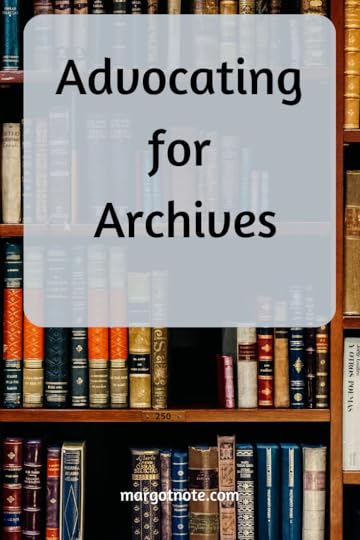
January 23, 2023
Offsite Storage for Organizational Archives
An increasingly important question for organizations is whether archival collections must or should be located within the same facility as the organization.
Traditionally, an entire repository was united in one space. However, as collections and activities grew, additional storage was sought by some organizations, often initially viewed as a temporary solution. The organization could provide storage in its more remote buildings or procure vendors specializing in the service. Many organizations realized that offsite storage would be difficult or impossible to replace with onsite storage, given the scarcity of valuable land for building. Often, deciding whether to integrate all collections or formally adopt an offsite storage model is difficult.
Advantages of Onsite StorageOffsite storage in the past has been characterized by ad hoc solutions using low-quality space or seen as a bunker that is locked up and forgotten, which has given offsite storage a bad name. However, there are now numerous examples of large and small organizations that use state-of-the-art collection facilities that offer top-quality storage and excellent support space ranging from essentials such as loading docks to conservation labs, specialized project rooms, and offices.
When collections are stored onsite, all building capital and running costs are assumed in one building. Staff efficiency is maximized by reducing travel outside the building or waiting for materials to be delivered. Collections are less frequently exposed to the outside environment and to travel hazards. Most importantly, collections are easily accessible for research and collaborative projects.
Disadvantages of Onsite StorageOn the other hand, renovating and upgrading building systems is more difficult in a single facility. As the building ages, conditions may deteriorate and harm materials. Staff efficiency is reduced if onsite storage is overcrowded and equipment is outdated, collections become less accessible in crowded storerooms, and overcrowding may cause damage. When stored onsite, collections compete for other types of public and scholarship space and often are moved to subpar areas of the building.
Advantages of Offsite StorageIt is possible, though expensive, to provide a facility purpose-built for storage without compromises due to other building needs. Storage can be supported by specialized facilities such as labs and workrooms that cannot be accommodated onsite. The cost of an offsite facility may be lower than onsite buildings due to land costs, different construction methods, and storage and support space consolidation more efficiently. Offsite storage can take the pressure off the main facility and allow greater flexibility in allocating space to evolving archival functions. Offsite space may also offer greater opportunities for future expansion, especially if additional land is part of the initial package.
For many institutions, building a custom storage solution is not a possibility. Instead, they can send materials offsite through a vendor. In addition, they benefit from having the vendor responsible for storage, transport, and management. Vendors can also scan documents and provide tracking capabilities for the organization.
Sending materials offsite frees up office space. Records storage facilities provide security measures to ensure records safety from those not authorized to view them. They also use climate controls to regulate temperature and humidity and fire-suppressant storage for heat to keep records protected.
Disadvantages of Offsite StorageOffsite storage requires regular movement of staff, goods, and collections between locations, and any movement of collections involves some level of risk. Buildings offsite require some duplication of support facilities. A more remote location may pose additional security risks and a different security strategy.
Offsite storage can also be surprisingly expensive. Storage fees from vendors are low per box, encouraging organizations to send their materials to storage. However, removing unnecessary boxes later or destroying files after disposition dates is much more costly. If organizations send records offsite without good reason, clear descriptions, or well-defined retention dates, they will pay more than is necessary for this service.
Prioritizing LocationsSeveral organizations have found that while large-scale offsite storage repositories are their best option for the bulk of their collections, they may not be the best option for all. Highly valued and frequently accessed collections may need to be housed closer to home. Thus, a combination solution may be envisioned, with selected collections onsite and massed collections offsite.
Offsite storage offers excellent possibilities for improving an institution’s ability to provide high-quality storage and support space for its collections; this is increasingly so when prime land and building costs have skyrocketed in many urban areas. However, for offsite storage to be the best solution and provide optimal conditions for the collections, it needs to be approached with the same planning rigor as any other project. Furthermore, it is not the only facilities solution and should be weighed against all other options to find the unique combination that meets the organization’s current and future needs.
The blog was originally published on Lucidea's blog.
Get StartedLooking for archival advising, records management, and historical research services? Click below to speak with an expert consultant.
Contact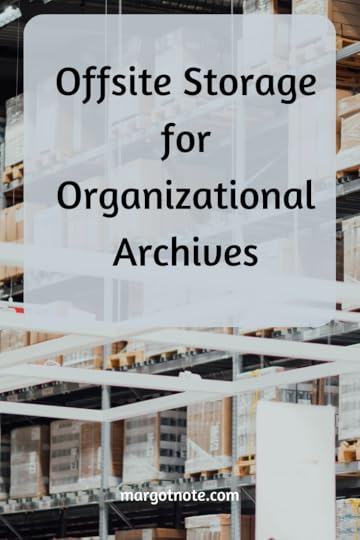
January 16, 2023
Placing Organizational Archives in Repositories
While archivists process historical holdings, storing the materials may require additional space within or outside the institution.
After conducting an archival assessment, archivists can determine if the existing space will suffice. They will also want to consider how often staff members and users need some materials compared to others.
One solution is offsite storage. Onsite holdings can store well-used materials, while offsite locations store the rest. The offsite vendor handles the storage, protection, and transfer of materials and frees up resources and space within the organization. However, one major disadvantage is that all materials are not immediately available. Therefore, planning is necessary to ensure access to the materials when needed.
Possibilities of PlacementAnother solution is to find a different custodian of the collection altogether. Given limitations on time, space, and money at the organization, archivists may consider the possibility of placing their records of enduring value in an archival repository. Repositories in public, academic, or private institutions specialize in preserving and making accessible manuscript collections and institutional records from various sources. However, institutions should weigh the pros and cons of this option carefully. Depending on the geographical location and collection strengths, finding an appropriate repository for the archives may be easy, or it may require an extensive, lengthy search. Large universities, for example, often have well-known archival repositories within large metropolitan areas. It may be more challenging to identify appropriate repositories in smaller communities.
Making ChoicesAll manuscript repositories have collection development policies with distinct collecting scopes. Understandably, they cannot acquire every archival collection offered. Organizations will want to initially investigate repositories that specialize in similar collecting subjects or a repository with which the organization already has a relationship. Depending on the institution, founders or prominent people within the organization may have strong ties with their alma maters; these universities often are interested in collecting the papers of their graduates or the records of organizations with which they associate.
Starting a ConversationIn discussing the possibility of placing archival materials in a repository, the organization may wish to evaluate the repository’s policies regarding:
Deeds of gift detailing the ownership of the intellectual and property rights of the materials
Schedules of transfers to the repository describing the timeframe for initial and future additions of archival material
Understandings of how the repository will make materials available to the organization when needed
Processing strategies, procedures, and timelines
Creation of inventories and finding aids, their granularity, and expected publication date
Restriction agreements describing what materials should be restricted and for how long
Providing financial assistance for processing and housing records
In considering an appropriate repository for the organizational archives, the institution will also want to consider the location and the ease with which the records can be transferred and accessed. While high-profile repositories offer prestige, the organization may wish to consider other options if they are remote or restrictive. Conversely, organizations may not exist forever, so establishing a relationship with a repository is prudent, even if the archives remain in-house for the time being.
Match MakingAs a consultant, I often help place personal or organizational archives into repositories. The key to that work is having honest conversations about what is possible to do and within what period; managing expectations is essential so that the organization and repository share common ground about how the collection will be protected and used. Equally important is an inventory of the materials to be donated. Subject descriptions, date ranges, locations, conditions, notes, total linear feet, and other details about the collection make transferring and accepting materials easier for repositories. Having a clear idea of the content and context of an organization’s collection allows repositories to steward organizational records of enduring value. .
The blog was originally published on Lucidea's blog.
Get StartedLooking for archival advising, records management, and historical research services? Click below to speak with an expert consultant.
Contact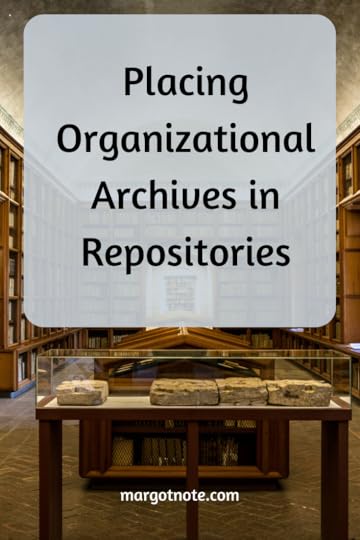
January 9, 2023
Public Use of Organizational Archives
An archival program within an organization supports employees, allowing them to work more efficiently and retain organizational knowledge.
While staff members have internal needs for organizational archives, individuals external to the institution may also have reason to consult the collection.
Accommodating Outside ResearchersIn planning for researcher inquiries, archivists determine the means and extent to which the records will be available to those outside the organization. Many inquiries will relate to the organization’s mission, programs, and legacy. Most requests will be satisfied by placing a short organizational history and a timeline of significant events on the organization’s website. For many organizations, at least initially, providing onsite access to their records is impossible due to staffing, space, or other limitations. In those cases, the archives’ online presence is even more essential.
Additionally, a list of Frequently Asked Questions (FAQs) can be posted online and updated as questions arise. User statistics related to inquiries can inform decisions regarding priorities for adding content to the website. As researchers request specific documents, for example, archivists may choose to digitize those items and make them available online.
Speaking from my experience at a past employer, I offered access to archival materials virtually only. Most organizational files contained sensitive information that could not be shared. Instead, I provided what I could, digitizing materials for users and adding the digital files to the archives. Digitizing and posting all major publications onto the website also supplied enough material for users to browse on their own without archival intervention.
Establishing Policies for Public UseEstablishing and publishing policies for outside researchers saves time and helps the organization handle unexpected requests. Information regarding how and when researchers may visit; how individuals register to use the archives; what kind of copying facilities, if any, are available; and permissions to publish material from the archives should be published online.
While some organizations may not have the space or resources to provide onsite reference services for outside researchers, archivists should become familiar with these issues. The archives may require in-person researchers to schedule an appointment and identify what material they wish to see before arriving; this is often done via an online form. Registering readers enables organizations to track the archives’ use and the purpose of the reader’s visit and verify identity for security purposes.
Reading RoomWhile having a formal reading room such as one at an academic library is not necessary, archivists should consider providing an area to check bags and coats safely and securely. There should be a table and chair large enough to accommodate the material they wish to see, preferably with an outlet nearby for laptops. The table should be within viewing of an employee for security purposes. Provide pencils for taking notes. Pens, which could permanently mark materials, should not be used by researchers.
Typically, reading rooms have rules that readers are expected to abide by. A copy of the rules should be reviewed and given to the user. These rules may also be posted on the organization’s website so that the researcher knows the rules in advance. After a user has identified, via the inventory, what boxes they wish to see, a staff member retrieves the material and provides it to the user. To ensure the preservation and order of the material, users should use one box, and one folder from that box, at a time.
If the organization allows photocopying or scanning of material, archivists should be responsible for the actual copying to ensure careful handling; the researcher can use acid-free flags to identify items to be duplicated.
Keeping Statistics and OutreachThe organization should maintain a record of what material is used by users. In this way, use can be measured statistically rather than anecdotally. These statistics can be helpful when determining what material should receive additional preservation or digitization, when reporting on the activities of the archives to administrators and board members, or when applying for grant funding for the archives.
If an organization can regularly make its archives available onsite to the public, it may consider including a description of the archives for potential researchers in national, state, or local online catalogs.
The blog was originally published on Lucidea's blog.
Get StartedLooking for archival advising, records management, and historical research services? Click below to speak with an expert consultant.
Contact
January 2, 2023
The Value of Archival Labor
With a records retention schedule, retention policy, and collection policy in hand and ideal storage located, the archives program can work on the arrangement and description (also known as processing) of the records of enduring value.
Within each department, the archivist will refine the arrangement of materials to be prepared for the archives, rehouse material, and create inventories to facilitate future access by staff members and other researchers.
Original Order or ReorderingWhile the material that arrives at the archives from various departments may be in an orderly arrangement, some records often need to undergo substantial reordering. Employees use documents for different purposes and retain and reorder the documents to serve necessary ends, such as reviewing invoices or consulting past correspondence. Archivists aim to maintain the integrity of the original order in conjunction with future accessibility. Through conversations with records creators, archivists become aware of how documents are used before arriving in the archives and exercise common sense in creating order and arrangement.
Not all records need to be or should be reordered. Often documents arrive directly from the person who created them and should be kept in this original order. However, in many instances, the documents arrive in a less organized manner with unclear original order. Therefore, archivists should rearrange them in favor of accessibility.
Handling DuplicatesArchivists frequently find multiple copies of the same document within departmental and individual files. By developing policies about duplicates, the archives can eliminate unnecessary material and free up valuable shelf space or data storage. Once the archivist has sufficiently arranged records of enduring value that have arrived in the archives—balancing original order and accessibility—it is time to begin the description process. Series, or grouping of records with the same provenance, will be identified and numbered (usually according to a hierarchical arrangement based on the organizational chart) and further subdivided into subseries.
During processing, archivists should inventory the contents of each box and an assigned box number. Then, create a listing or inventory of the records that reflect the arrangement of the documents and include the box and folder number numbers to enable physical access to specific records.
The Value of Archival LaborArchival processing requires more than one person to handle the labor, especially for more extensive collections. Organizations often depend on non-professional labor, such as interns, volunteers, or other well-meaning people who can lend a helping hand. Using untrained labor not only devalues the archival profession but has the potential to cause significant problems within the archival collections that will take even more time, labor, and resources to fix. Investing in archival insight from the beginning of the project allows for proper practices to be in place, making a more efficient and sustainable archival program in the long run. As an archival consultant, I strongly believe in hiring experts to handle archival projects. Far too often, I have been hired after other less expensive options have been exhausted, and significant problems to the foundations of the archival program have been institutionalized. Processing is one area where seeking expertise before committing to any action plan is a rational choice. There is no need to jump into initiatives that will shape organizational legacy without the aid of a trained archivist.
Organizational archives are living programs that change and reflect the organization. Archival work is never completely done; there is always more an archivist can do. Investing in archival staff is another way to ensure that the archives program endures. While part-time staff or a consulting archivist can help with projects or specific stages of the program’s maturity, an archivist on staff provides the constant vigilance and labor needed to create an archives that supports an organization’s mission.
The blog was originally published on Lucidea's blog.
Get StartedLooking for archival advising, records management, and historical research services? Click below to speak with an expert consultant.
Contact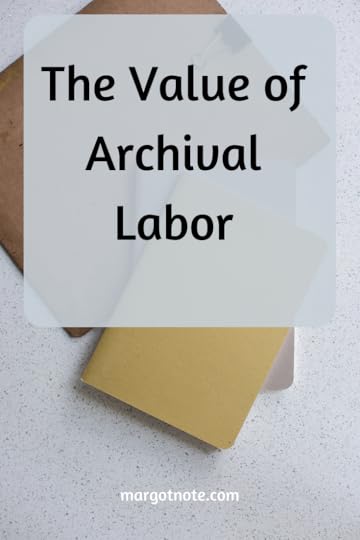
December 19, 2022
Finish Your Family History Projects
I've written a lot about family archives over the years, but sometimes my readers miss a post or are new to my community. I've listed my posts related to how anyone can learn methods to save their personal and family history.
Learn the preservation secrets used by libraries, archives, and museums to protect their priceless materials (that you can also use for your family heritage items) by ordering my book:
Creating Family Archives: A Step-by-Step Guide to Saving Your Memories for Future Generations By Margot Note Buy on Amazon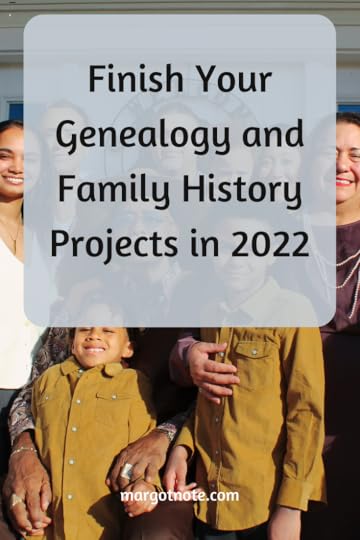
November 28, 2022
Records Disposition for Archives
Determining the flow of an organization’s records ensures that archivists schedule materials for disposition.
In addition, archivists can liaise with departments within their organizations to help retain significant documentation and inclusion of those records within the archives. If there is not already one, creating a records retention schedule should be one of the archivists’ first tasks after an archival assessment.
Records Retention ScheduleThe records retention schedule organizes a list of documents by department, thus identifying records, their creators, their retention periods, and their disposition. The finance, legal, and administrative departments and department heads should supply input to draft the schedule. Although a spreadsheet can outline a basic retention schedule, organizations may wish to consult a records manager or legal counsel to assist in this process, especially for highly regulated industries. Once formalized, the records retention schedule will assist in the straightforward assessment of materials to determine short- and long-term retention. Most records subject to the retention schedule will easily fall within two areas: lifecycle (temporary) or archival (permanent) records.
Organizations retain temporary documents for determining lengths of time for legal purposes. Determining the appropriate lifespan ensures that an organization keeps these records only so long as legally required. A records retention schedule and policy sets calendared destruction dates to dispose of the records once they are no longer needed or the lifespan expires.
On the other hand, institutions retain other records in perpetuity. These documents comprise the bulk of the archival collection and include many materials that chronicle the institutions’ operations.
Identifying these record categories assist in managing documents. Handling temporary documents leaves more time for the detailed work of managing archival materials. Designating areas to retain documents before disposition helps isolate these documents from the archival collection and makes monitoring for ultimate destruction easier. A spreadsheet or database can track retention. Archivists or records managers can use the contents of the boxes, such as date range, department, and box or location number, as data fields. Once they have reached the retention cut-off, employees can dispose of them. Shredding documents the organization and ensures compliance with state and federal laws. Many shredding companies offer secure mobile shredding or off-site document destruction.
Retention for ArchivesWhat constitutes records of enduring value will differ slightly for each institution and reflect the organization’s mission. However, archives should permanently retain items that chronicle the institution and its place in a historical context.
The archives department should set a retention policy for materials and include this policy in recordkeeping manuals with the retention schedule. In addition, the policy should include a checklist of desired archival documents to help with retention and establish an order for the records to be maintained once employees move the materials to the archives.
Filling in GapsOnce archivists have a handle on an organization’s current documents by creating a retention policy and schedule, they can focus on materials that are missing. A collection or acquisition policy identifies the materials the archives seeks to acquire. For most institutions, the collection policy should include only materials that directly support or enhance the organization. Donations of materials should fall in line with this policy. Establishing clearly defined collecting areas might consist of areas outside the immediate organization.
The collection policy should also note material to supplement gaps in archival holdings, such as material from the institutions’ early years. An oral history program is an excellent way to capture the history of an organization. Forging meaningful relationships with people involved in the organization’s founding may be the most important step toward guaranteeing document retention. Doing so increases the archives’ potential for scholarship, legacy, and shared resources.
The blog was originally published on Lucidea's blog.
Get StartedLooking for archival advising, records management, and historical research services? Click below to speak with an expert consultant.
Contact
November 21, 2022
Safe Storage for Archival Preservation
Many organizations have little room to store archival collections, so rare and fragile materials often end up in less-than-ideal locations.
In addition, most materials deteriorate over time, especially audiovisual materials, so a vigilant eye is needed to protect the items chosen for archival collections.
Environmental ConcernsAreas housing archival collections should be climate-controlled and monitored to protect materials. Climate standards for archives are 68 degrees Fahrenheit and 50% Relative Humidity. However, keeping stable temperature and humidity levels is preferable to pursuing an ideal of climate control that may be difficult to reach in many buildings. If organizations must store archival collections in attics or basements, or areas subject to environmental hazards, archivists must take the steps necessary to protect the items by installing metal shelving units, protecting boxes with tarps, and removing sensitive materials to ensure a more stable environment.
Keeping one step ahead of environmental concerns is only part of the preservation effort. Materials identified for retention in perpetuity will often need to be cleaned or repaired and will have to be re-housed in archival boxes and folders.
Archivists should immediately isolate items and treat the damage if archival documents have been damaged by water damage, mold, and light exposure. Mold can be dangerous if inhaled, so it is best to consult a specialist who can advise on the treatment if necessary.
Safe SuppliesAt the fundamental level, archival items should be boxed and stored on metal shelves in areas not subject to waterways, windows, vents, or excessive fluorescent lighting. Use acid-free sleeves and boxes to store the materials and place these boxes in easily accessible, temperature-controlled rooms. Keep these rooms free from food and beverage use. Purchase inexpensive UV fluorescent light filters to protect archival collections from fading due to prolonged light exposure and keep a regular cleaning schedule to remove dust, dirt, and other materials from shelves and floors.
Archivists should communicate with the building maintenance staff to be aware of and negotiate cleaning services and changes to the temperature control and lighting of the archives room. For example, the organization might lower or turn off the building’s heat when the building is not occupied, but extreme temperature changes could damage records. Stabilize slides, photos, and negatives by housing these items separately from paper collections. Use archival-grade photo envelopes and sleeves to protect the film and label the sleeves with identifying information about the images.
If the organization lacks funding for archival supplies, store the items in size-specific folders and boxes of the highest quality available, given the budget. Do not overstuff or under-pack the boxes. Archivists want to create an environment in the box whereby the documents are easily pulled for access and not bent when removing documents. Archivists should label each box with date ranges and content descriptions and purchase reams of acid-free paper to interleave material and as dividers within the boxes.
Woman or Man with a PlanA well-planned emergency plan should also be in place should unforeseen natural disasters affect the archival holdings. Appoint staff members to ensure proper handling of the damaged materials and have a plan for dealing with the damage. Staff members should share the plan with their colleagues, and multiple copies should be kept inside and outside the organization. The plan should also include emergency phone numbers, including local organizations that can aid the theatre in case of damaged materials, such as the Northeast Document Conservation Center, whose leaflets can be helpful when preservation crises arise.
While most companies will not have the resources to conduct a complete preservation survey and follow-up treatment, staff members should become familiar with triage methods. In addition, emergency supplies, including plastic drop cloths and a wet vac, should be on hand for the archives. Types of natural disasters that affect the institution’s geographic area, such as flooding or earthquakes, will dictate the most useful emergency supplies. Discuss this emergency planning with the administration, so the institution-wide plan integrates the archives.
The blog was originally published on Lucidea's blog.
Get StartedLooking for archival advising, records management, and historical research services? Click below to speak with an expert consultant.
Contact



